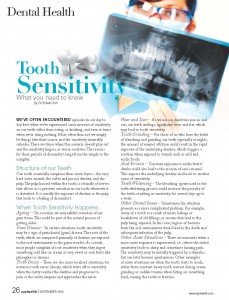 This article first appeared in the September 2013 issue of Ezyhealth magazine. We have reproduced it for the information of those of you who missed it when it was published.
This article first appeared in the September 2013 issue of Ezyhealth magazine. We have reproduced it for the information of those of you who missed it when it was published.
We’ve often encountered episodes in our day to day lives when we’ve experienced some measure of sensitivity on our teeth either from eating or drinking, and even at times when we’re doing nothing. More often than not we simply let things take their course, and the sensitivity invariably subsides. There are, however, times when this scenario doesn’t play out and the sensitivity lingers, or worse, escalates. The reasons for these periods of discomfort range from the simple to the complex.
Structure of our Teeth
Our tooth essentially comprises three main layers – the very hard outer enamel, the softer and porous dentine, and the pulp. The pulp housed within the tooth is a bundle of nerves that allows us to perceive sensation in our tooth whenever it is disturbed. It is usually the exposure of dentine or the pulp that leads to a feeling of discomfort.
When Tooth Sensitivity Happens
Ageing – On occasion, we may exhibit recession of our gum tissue. This could be part of the natural process of getting older.
Gum disease – In certain situations, tooth sensitivity may be a sign of periodontal (gum) disease. The roots of the teeth, which are comprised primarily of dentine, are exposed to the oral environment as the gums recedes. As a result, most people complain of root sensitivity when they ingest something cold like ice cream or very sweet or sour fruits like pineapples or lemons.
Tooth Decay – There are also more localised situations, for instance, tooth caries (decay), which starts off as sensitivity when the cavity reaches the dentine and progresses to pain as the cavity deepens and approaches the nerve.
Wear and Tear – As we use our dentition year in and out, our teeth undergo significant wear and tear which may lead to tooth sensitivity.
Tooth Grinding – For those of us who have the habit of clenching and grinding our teeth especially at nights, the amount of enamel attrition could result in the rapid exposure of the underlying dentine and leads to another cause of sensitivity.
Acid Erosion – Constant exposure to acidic fruits/drinks could also lead to the erosion of one’s enamel. This exposes the underlying dentine and leads to another cause of sensitivity
Teeth Whitening – The bleaching agents used in the teeth whitening process could increase the porosity of the teeth, resulting in sensitivity for several days up to a week.
Other Dental Issues – Sometimes, the situation presents as a more complicated problem. For example, decay of a tooth as a result of micro leakage or breakdown of old fillings, or crowns that lead to the pulp being exposed. In this case, ingress of bacteria from the oral environment would lead to the death and subsequent infection of the pulp.
Other Acute Situations – There are moments when a more acute response is experienced, i.e., where the initial sensitivity leads to sharp and sometimes lancing pain. The sensitivity may be initially triggered by a stimulus but can later become spontaneous. Other examples of acute situations are when the tooth starts to crack, either from constant heavy tooth contact during severe grinding or sudden trauma when biting on something hard, causing the tooth to fracture.
Tooth sensitivity should not be taken lightly. In most cases the solution is simple; however, there are times when the case could be more serious. It is, therefore, best to seek the expertise of a dental surgeon before dismissing it as something trivial.
What Can Be Done
So what can we do when we encounter this situation with its wide plethora of possibilities?
- See your Dentist – Making an appointment to seek consultation with a dental professional is the first line of action
- Usually a thorough examination including X-rays and the performing of certain tests would reveal which tooth is the culprit, and what the underlying cases may be
- Diet Change – In cases of attrition and erosion, preventive measures such as changing one’s diet as well as wearing a night guard could help mitigate some of the wear and tear associated with this cause.
- Desensitisation – Desensitisation with chemical blocking agents and vanishes is another solution which usually alleviates the mild generalised sensitivity associated with root or dentine exposure. Your dentist should also prescribe the regular use of desensitising toothpaste to serve as an adjunct to the in-clinic desensitisation. This strategy involves the blocking of the porosities on the dentine or root surface thereby preventing the underlying nerve from being irritated.
- Dental Treatment – If decay or failing restorations are detected, then the best option would be to redo the restorations involved to re-establish a good seal on the tooth.
In the severe cases where the pulp of the tooth is already involved, whether as a result of decay or trauma, root canal therapy followed by a definitive restoration would be the treatment of choice to save the tooth and to prevent subsequent infection of the surrounding structurses.
Words of Advice
Tooth sensitivity should not be taken lightly. In most cases, the solution is simple; however, there are times when the case could be more serious. It is, therefore, best to seek the expertise of a dental surgeon before dismissing it as something trivial.





